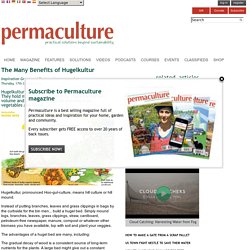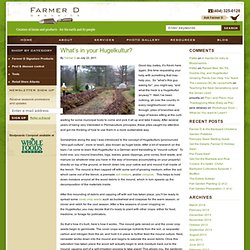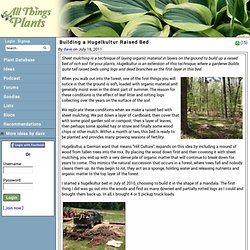

The Many Benefits Of Hugelkultur. Hugelkultur, pronounced Hoo-gul-culture, means hill culture or hill mound.

Instead of putting branches, leaves and grass clippings in bags by the curbside for the bin men... build a hugel bed. Simply mound logs, branches, leaves, grass clippings, straw, cardboard, petroleum-free newspaper, manure, compost or whatever other biomass you have available, top with soil and plant your veggies. The advantages of a hugel bed are many, including: The gradual decay of wood is a consistent source of long-term nutrients for the plants. A large bed might give out a constant supply of nutrients for 20 years (or even longer if you use only hardwoods). Soil aeration increases as those branches and logs break down... meaning the bed will be no till, long term. The logs and branches act like a sponge.
Sequester carbon into the soil. On a sod lawn Sepp Holzer (hugelkultur expert) recommends cutting out the sod, digging a one foot deep trench and filling the trench with logs and branches. Further resources. Hugelkultur: The Ultimate Raised Garden Beds. Raised garden bed hugelkultur after one month raised garden bed hugelkultur after one year raised garden bed hugelkultur after two years raised garden bed hugelkultur after twenty years It's a german word and some people can say it all german-ish.

I'm an american doofus, so I say "hoogle culture". I learned this high-falootin word at my permaculture training. Hugelkultur is nothing more than making raised garden beds filled with rotten wood. I do think there are some considerations to keep in mind. Another thing to keep in mind is that wood is high in carbon and will consume nitrogen to do the compost thing. Pine and fir will have some levels of tanins in them, but I'm guessing that most of that will be gone when the wood has been dead for a few years. In the drawings at right, the artist is trying to show that while the wood decomposes and shrinks, the leaves, duff and accumulating organic matter from above will take it's place. What’s In Your Hugelkultur? Good day mates, it’s Kevin here again, this time requesting your help with something that may help you.

So “what’s this guy asking for”, you might say, “and what the heck is a Hugelkultur anyway”? Well I’ve been noticing, all over the country in every neighborhood I drive through, piles of branches and bags of leaves sitting at the curb waiting for some municipal body to come and pick it all up and take it away. After several years of being very interested in Permaculture principles, these piles caught my attention and got me thinking of how to use them in a more sustainable way. Somewhere along the way I was introduced to the concept of Hugelkulturs (pronounced “who-gull-culture”, more or less!) , also known as hugel beds. After this mounding of debris and capping off with soil has taken place, you’ll be ready to spread some cover crop seeds such as buckwheat and cowpeas for the warm season, or clover and vetch for the cool season.
-Kevin Frazier. Building A Hugelkultur Raised Bed (All Things Plants) Sheet mulching is a technique of laying organic material in layers on the ground to build up a raised bed of rich soil for your plants.

Hugelkultur is an extension of this technique, where a gardener builds quite tall raised beds using logs and dead branches as the first layer in this bed. When you walk out into the forest, one of the first things you will notice is that the ground is soft, loaded with organic material and generally moist even in the driest part of summer. The reason for these conditions is the effect of leaf litter and rotting logs collecting over the years on the surface of the soil. We replicate these conditions when we make a raised bed with sheet mulching. We put down a layer of cardboard, then cover that with some good garden soil or compost, then a layer of leaves, then perhaps some spoiled hay or straw and finally some wood chips or other mulch. How to Build Irrigation-Free Raised Beds with Hugelkultur. Paul Wheaton/Video screen capture I've posted a video by Paul Wheaton on how to build "hugelkultur" raised beds before.

But with the tantalizing promise of vastly reducing, and possibly even eliminating, the need for irrigation, it seems like a topic worth revisiting. Developed by Austrian hill farmer Sepp Holzer, hugelkultur at its simplest is a process of piling up logs, brush and other carbon-dense biomass, and then building up raised bed gardens over the top of those piles using top soil and compost. The theory is that the biomass slowly decomposes over time, feeding the plants above with nutrients and also providing a sponge-like layer beneath the growing substrate—absorbing and rereleasing water to the plants as needed. As I mentioned in a previous article on hugelkultur, the process can be taken to what looks like relatively industrialized extremes—using diggers and earth movers to pile up biomass over huge distances. Anyone have any insights?